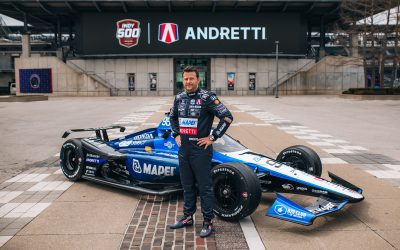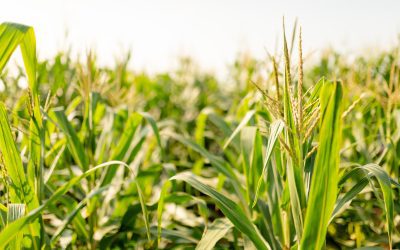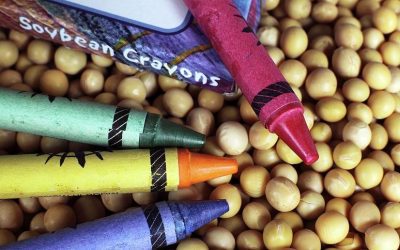World’s eyes remain fixed on the U.S. grain market
Posted: November 2, 2022
Category:
Indiana Corn and Soybean Post - Fall 2022, ISA, News
SPECIAL STORY BY ANN, HEE KYOUNG Reporter for The Agriculture, Fisheries & Livestock News, Seoul, Korea
In the future, stockbrokers will drive taxis and wise farmers will drive Lamborghinis.”
Jim Rogers, a world-renowned investment expert, once recommended that young people choose agriculture as their major instead of a master’s degree in business administration and predicted that agriculture would become a future-oriented industry.
Perhaps Rogers was right. The world’s eyes are now focused on the U.S. grain market due to the growing instability in grain supply and demand caused by the war between Russia and Ukraine, and the fallout from the COVID-19 crackdown on grain warehouses. The United States is the world’s largest corn producer and the world’s second largest soybean producer.
U.S. farmers are making generous investments in agriculture and approaching it as a future-oriented industry.
With the help of the Indiana Soybean Alliance (ISA), Korean food industry workers who have achieved outstanding results among the Soy Oil Masters graduates established by the American Soybean Association (ASA) recently visited Indiana to learn about the future direction of U.S. agriculture and the soybean industry. This visit helped participants consider the future direction of agriculture through the current state of agriculture in the United States.
Indiana leads in high oleic soybeans
As of last year, the U.S. produced 4.44 billion bushels (120 million tons), or 57 million metric tons, of soybeans alone. This accounts for 35.9 percent of all global exports.
Indiana, along with Illinois, Iowa, Nebraska and Ohio, is among of the major U.S. soybean producers with more than 20,000 farmers cultivating soybeans. In addition, 60 percent of the soybeans produced in the Indiana are processed in the state, and the soybean industry is a major industry in Indiana.
ISA, Indiana’s soy checkoff program, provides a variety of educational opportunities to soybean importers through self-help funds to increase U.S. soybean preferences and market accessibility. In particular, ISA opens various promotional and educational programs where expectations for the Korean market are high.

“Korea is one of the largest importers of U.S. soybean oil and plays a central role in innovative ideas in the U.S. soybean oil business,” said William McNair, Director of Human Nutrition and Oil of the U.S. Soy Export Council (USSEC).
Indiana, which produces the most high-oleic soybeans in the U.S., has recently attracted attention and is expected to become a mecca for the soybean-related industry.
Soy Oil Masters program produced soy oil experts
“The Soy Oil Masters program is one of the continuous programs to train soy oil experts,” McNair said.
The Soy Oil Masters program is a free, training course for Korean food service industry workers from the American Soybean Association to inform them of the nutritional value, economic value and advantages of soy oil in food processing. In particular, the Soy Oil Masters Program has become a global program operated not only in Korea but also in Japan, China, Taiwan and Latin America, increasing its expertise every year.
Starting with 79 Soy Oil Masters in 2018, 89 Soy-oil Master in 2019 and 83 Soy Oil Masters in 2020, 102 Soy Oil Masters were trained in 2021. A Master is someone who has passed a certification test. Each Master will be provided with continuous market conditions and technical information.
Top participants are provided with the privilege of visiting the U.S. soybean industry. In fact, 14 out of the first-term masters were selected and toured the U.S. soybean industry in 2019. The second- and third-term industrial tours were postponed by COVID-19 until this year.
Some 20 Soy Oil Masters who visited Indiana in August were selected for their outstanding performance among the second and third terms, including experts from leading Korean food companies such as Jeong Foods, Samyangsa, Sam-Yuck Food and Lotte Food. In particular, the program’s training was enhanced through courses provided by ISA and tours of Indiana’s rising industries.
Hwang Soo-ji, a researcher at Lotte Food, said, “This tour helped to understand the U.S. soybean industry as well as sustainable agriculture.”
Yoo Dong-jin, a researcher at Samyangsa Corporation, said, “I was very interested in the oil market. In this tour, I was very happy to have get professional information directly from the U.S. soybean producers.”
Demand puts high oleic soy in short supply
What is the difference between high oleic soy oil and conventional soy oil?
High oleic soybean oil has the highest oxidation stability among commercial oils and is suitable for tempura oil. In particular, high oleic soy oil is gaining popularity as it has been proven to maintain healthy body blood components and reduce the risk of cardiovascular disease.
According to a study by Corteva, a multinational agricultural company, U.S. soybean oil actually has a 0.5-1 percent higher oil content than other countries’ soy oil.
“High oleic soy oil has the highest stability in commercial oils, but this stability is due to changes in fatty acid composition and the inclusion of beneficial antioxidants,” said Susan Knowlton, a senior researcher of Corteva
For this reason, the popularity of high oleic soy oil has increased recently, and the planting of high oleic soybeans has doubled for two years from 2020 to this year. But the supply has been insufficient due to increased demand. Due to the recent war between Russia and Ukraine, the supply of oil has become difficult, and the imbalance in supply and demand of oil has led to a general shortage of soybeans.
Ed Ebert, ISA Senior Director of Market Development, said, “We will produce more high oleic soybeans next year, but you need to make an early decision if you want to buy them because of the increased demand.”

U.S soybeans, importantly, are sustainable
Officials explain that the difference between U.S. soybeans lies in ‘sustainability’ rather than high quality.
“The biggest difference between the U.S soybean and soybeans produced in other countries is that – compared to Brazil and Argentina – U.S. soybean growers emit less greenhouse gas and have no problems such as deforestation, labor or exploitation,” McNair said.

In fact, the soybean farmers I met in Indiana clearly practiced the value of sustainability.
The Howell family farm in Middletown, Ind. is a large-scale farm that grows soybeans and corn. The Howell farm, which is run by family members without external investment. For two generations, this farm has followed environmentally sensitive sustainability practices.
Create a stable business model
Kevin Kelley, ISA Board Member and soybean and corn producer from Brookston, Ind., makes a side income from repairs to farm equipment and electricity generated by wind farms. Agricultural machinery-related projects are targeted not only in the U.S. but also in Canada.
There are also farms that realize sustainable agriculture on a different model.
“My son and I take specialized machinery classes to repair all agricultural machinery necessary for cultivation, as well as repairing agricultural machinery in Indiana,” Kelley said. “Since crops are affected by external factors such as climate and crop conditions, we are building a farm management system.”
ISA Board Member Gary McDaniel, a farmer from Boonville, Ind., said sustainability is about preparing for the future. “I run a 1,500-acre farm (6,072,84 square meters) with corn, soybeans and livestock,” McDaniel said. “My 29-year-old son and his 5-year-old grandson farm together. More than 20,000 soybean farmers in Indiana, like me, are building farms for future generations.”
He added, in addition to protecting the rights and interests of soybean farmers, Indiana farmers are also engaged in many social activities. McDaniel opens his farm to hundreds of newlyweds for weddings.
“I’m really happy to spend a lot of time with my family and work with them,” he said. “We strive for sustainable agriculture by maintaining our strength and minimizing our work in order to hand over farms that have been built for several generations, for more than 120 years, to future generations. The 120-year history of the farm is the pride of our family. I will continue to work for future generations.”
Soy Oil Masters a continuing program
“The Soy Oil Masters program does not end at the graduation ceremony, but it is the beginning of continuous support for those selected as masters to become soy oil experts,” said Lee Hyun-seok, Country Director of the Korean Office of USSEC. “We will continue to provide masters with opportunities to understand industries such as technical assistance, sharing market data, and inspecting the soybean industry so that the Soy Oil Masters program can lead to a comprehensive program representing the soybean oil industry.”
He added, “The visit of the U.S. soybean industry tour team will be a clue to understanding the U.S. soybean industry.” Korean soy oil buyers are interested in learning what they can about how American famers define sustainability. “To understand the rising industry in the United States, we need a deep understanding of ‘sustainability,’” Hyun-seok explained. “Looking at farms that have been farming for more than 200 years, I think we will be able to confirm the value beyond quality with the rise of the United States through consideration of U.S. agriculture.”

USSEC is raising the excellence and industrial understanding of the rise of the U.S. Soy industry through professional programs such as the Soy Oil Masters program, the Soy Oil Grand Master program, and the Soyfood Master program.
“Soybeans are an important ingredient in Korean diet,” Hyun-seok said. “I hope that there will be more soy masters in Korea through various programs prepared by the USSEC.”

Research led by latest technology
Another stop on the tour was Purdue University’s Corn and Soybean Innovation Phenotyping Center. Equipment in the greenhouses at Purdue University scans flowerpots moving on conveyor belts, records growth and humidity conditions, and collects the data.
Purdue University, which is considered a premier global agricultural university, is developing soybean seeds through phenotyping. This technology measures and analyzes crop growth conditions. In Korea, the Korea Institute of Science and Technology (KIST) started research to implement a Korean-style smart farm in 2015 and was introduced into a tomato cultivation smart farm in Taean, Chungcheong.
There are hundreds of start-up companies related to phenotyping that are flying drones over cultivated land, taking images, accumulating data on crops, and obtaining information on yields. Global seed companies such as Bayer, Syngenta and Corteva are doing their best to develop seeds by identifying better genes through phenotyping.
Purdue University has realized smart farms through phenotyping technology and is developing the best seed breeding through more precise analysis.
Jian Jin, assistant professor of agricultural biological engineering at Purdue University, said, “Phenotyping is a concept of traits that can be found as a result of genotyping related to genetics, which can check plant growth faster and more accurately.”
Purdue University has built a campus digital phenotyping facility and collects data 24 hours per day by scanning all plants with RFID (radio recognition) when greenhouse plants move through conveyor belts. Research is being conducted to confirm drought tolerance by changing conditions while collecting data.
Purdue University checks the condition of plants in two greenhouses and one growth room through a super-spectroscope system. If a television or monitor shows colors through RGB (red, green, blue), the super-spectroscope can show 500 colors, check the diseases, moisture and nutritional status of plants that cannot be seen by the naked eye, and judge growth more accurately. Purdue has invested $6.5 million in these types of research facilities and can grow up to 256 plants in the largest growth room in North America.
Indiana Corn and Soybean Innovation Center
Practical application of solutions to farm problems is essential to good research.
The Indiana Corn and Soybean Innovation Center at Purdue University, funded partly by ISA, is responsible for applying phenotyping and other soybean-related technologies directly to farms.
It is a practical space where even the corridor of the research building is used as a research space, and it serves as a model research complex for the Indiana soybean industry by cultivating corn and soybeans so that more accurate data can be collected and analyzed.
The Innovation Center sows seeds on a large-scale cultivated land based on GPS, then installs superspectroscopes developed by Purdue University and collects data directly.
If universities use related technologies to plant soybeans and corn, the innovation center will effectively anticipate the problems caused by applying new technology to cultivated land that is similar to Indiana’s environment.
In addition to research on soybean and corn seeds and cultivation, research has been conducted on equipment that can produce the best results. A thresher is a typical type, and when corn kernels are put in, they are classified according to color and grain size.
Corteva works to develop global seed
Corteva is an agricultural company that produces and sells many seed varieties. Along with Bayer and Syngenta, Corteva is regarded as one of the top three global agricultural companies. The company also produces and sells crop protection products such as herbicides and insecticides.
According to industry sources, Corteva accounts for more than 60 percent of the global seed market. Monsanto, which was acquired by German pharmaceutical company Bayer, and Syngenta, which was acquired by China’s ChemChina are the other major players.
According to Reuters, Corteva is estimated to account for 30 percent of the U.S. soybean market in 2021 – a strong year for soybean seed.
Corteva highlighted a variety of programs during a tour of their headquarters in Indianapolis, Ind. The Corteva headquarters’ laboratory, which focuses on crop protection agents is developing products through hundreds of thousands of tests.
Corteva said it takes 9-10 years for a single product to go from development to release and said, on average, it spends $256 million to develop safe and reliable crop protection products that it considers safe for farmers and consumers.
At Corteva’s research institute alone, there were 70 chemical experts and 350 researchers, including engineers and bioengineers.
A researcher at a Korean food company who visited the Corteva headquarters said, “The size of the laboratory and the budget itself are unimaginable. I was awed by the fact that the laboratory repeated hundreds of thousands of simulations for control.”
Technical research maintains productivity
The Corteva Research Campus in Indianapolis focuses on the crop protection business.
“Corteva is concerned about the efficiency and sustainability of food production and is working to help farmers to produce safe and nutritious food,” said Matt Rekeweg, U.S. Industry Relations and Food Chain Leader at Corteva.
“There will always be a need for pest control,” Rekeweg said of the shrinking crop protection markets, also known as agricultural chemicals. “Producing crops, or farming for food production, is different from ordinary plant cultivation. If we farm as it is, pest control is essential because we cannot meet the demand, at all, in terms of productivity.”
However, Corteva is also developing specific products to meet this global trend and studying technologies that can maintain productivity while using fewer chemicals.
The company is developing crop protection agents with technology that uses artificial intelligence to inject precise amounts during the process of spraying crop protection agents. Biological products that are not existing chemical products, i.e., products made through biological sources such as bacteria and fungi, are also under development. Corteva expects this new market to grow with the organic market.
“The ultimate goal of Corteva is to work with farmers to produce food that consumers want and to protect and use crops around the world efficiently,” Rekeweg said. “The most important thing is to work with producer organizations such as ASA and the ISA to maintain close ties with the food industry.”
Corteva has won the Environmental Protection Agency’s Eco-Company Award five times for its efforts.
Visiting the Glass Barn
The tour through Indiana featured various programs that allow visitors to experience the growth, characteristics and advantages of soybeans in the United States.
The Glass Barn, which opened in 2013, serves as an educational center to inform consumers of the strengths and uses of soybeans in Indiana. Located at the Indiana State Fairgrounds, the Glass Barn attracts thousands of visitors every year and features a simulation of how soybeans are harvested.
What is noteworthy is that the Glass Barn allows visitors to experience farming and soybean’s advantages through game consoles.
A large combine harvester simulator, located in the center of the Glass Barn, is a near life-sized display and is popular because visitors can feel the actual vibration when harvesting crops through a simulation program of harvesting soybeans.
The Glass Barn also educates consumers about high oleic soybean oil and allows visitors to talk virtually with farmers and industry experts in its virtual theater. During the tour, our group was able connect virtually with Corteva Senior Researcher, Knowlton, who talked to us more about higholeic opportunities. Ebert also took part in the discussion.
“High oleic soybean oil has no trans fat and is eco-friendly. I expect demand to increase,” said Ebert during the Glass Barn tour. “I think high oleic soy oil is a rediscovery of soy oil because 75-80 percent is oleic acid, less than 12 percent is saturated fatty acid. I think it is a very economical oil because it has good oxidation stability and uses tempura oil for a longer period of use, and from the standpoint of a food manufacturer, the storage period is longer. It was developed for food manufacturers, but recently it has been used in automobile-related products and is very useful in the chemical industry. It is eco-friendly and has a very high oxidation stability compared to canola oil.”

Ebert continued, “High oleic soy oil has less polymer accumulation and can be seen as less oily and less solidified than other oils and fats. The price is still a little high, but I think the higher the cultivation rate, the lower the price. The demand for high oleic soybeans will increase and the cultivation rate will continue to increase.
“Soy farmers in Indiana produce 70 percent of the U.S. high-Oleic soybeans. Indiana will be in the spotlight as the center of high-Oleic soybeans in the future. We hope more people will visit Indiana, visit the ISA, and get a lot of information. And I hope more people will try high oleic soy oil.”



